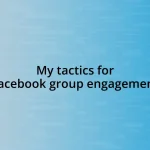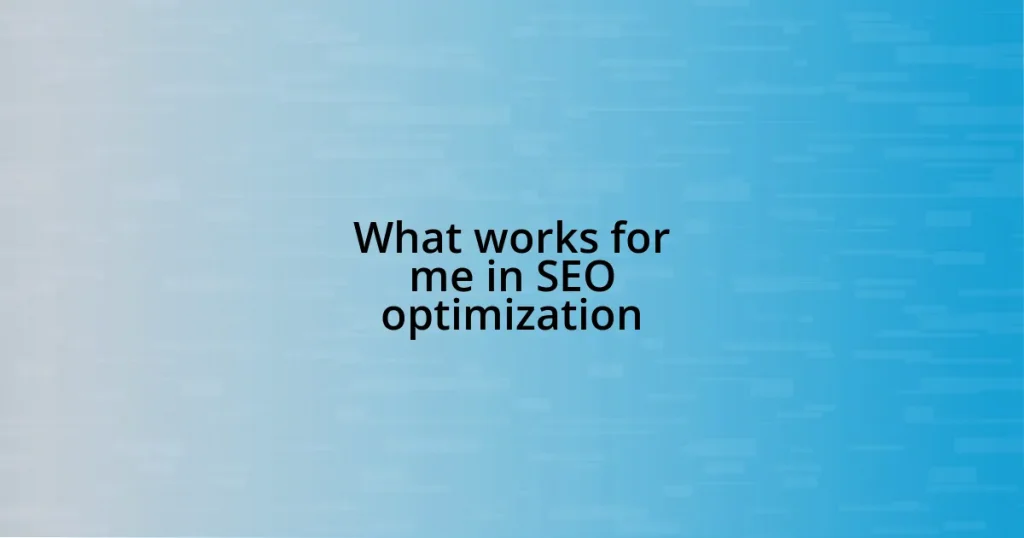Key takeaways:
- Understanding audience needs through feedback is crucial for effective communication and content alignment.
- Incorporating engaging formats, such as interactive quizzes and storytelling, enhances audience retention and emotional connection.
- Utilizing feedback to adjust content fosters a dynamic learning environment and turns passive listeners into active participants.
- Building community through shared experiences and recognizing audience contributions strengthens loyalty and engagement.

Understand Your Audience Needs
Understanding your audience’s needs is like unlocking the door to effective communication. I recall a time when I misjudged what my audience sought, leading to a disengaging presentation. It wasn’t until a few attendees approached me afterwards, expressing their confusion about the topic’s relevance, that I realized the importance of aligning content with their expectations.
Think about it: Have you ever watched a video or read an article that just didn’t resonate? It’s frustrating, right? By actively seeking feedback and observing your audience’s reactions, you can identify gaps in understanding. I remember conducting a simple survey after a webinar. The insights I gained were invaluable and reshaped my future content direction.
Every audience is unique, shaped by their experiences and environments. For instance, when I shifted my focus to include more storytelling in my presentations, the response was overwhelmingly positive. It made me realize that connecting on an emotional level isn’t just beneficial—it’s essential for keeping your audience engaged and invested.

Create Engaging Content Formats
Creating engaging content formats is essential for retaining your audience’s attention. One approach I’ve found particularly effective is mixing up different formats. For instance, I once combined traditional slides with video snippets during a workshop, and it felt like transforming a standard lecture into a lively conversation. The feedback was incredible; participants felt more energized and connected.
When I experimented with interactive content, like polls and quizzes, the engagement skyrocketed. People love to be part of the narrative. I’ve noticed that when my audience interacts directly, they remember the key points much better. It’s fascinating to see how a little bit of interaction can turn a passive experience into an engaging one.
Visual storytelling is another format that resonates deeply. I vividly recall a presentation where I used infographics to simplify complex data. It helped the audience grasp the information quickly, and they seemed much more interested and involved. Engaging formats can turn even dry topics into captivating stories, making retention much easier.
| Content Format | Engagement Level |
|---|---|
| Slide Presentations | Moderate |
| Video Snippets | High |
| Interactive Quizzes | Very High |
| Infographics | High |

Utilize Storytelling Techniques
Utilizing storytelling techniques can transform your content from mundane to memorable. I always find myself captivated by a well-told story; it pulls me in and keeps me engaged. For instance, during a recent digital marketing seminar, I shared a personal story about a challenging campaign I worked on. It not only conveyed my message but also sparked conversations among attendees, who resonated with the struggles and triumphs woven into my narrative.
- Structure Your Story: Begin with a relatable problem, build tension, and conclude with a resolution that ties back to your main point.
- Use Vivid Descriptions: Paint a picture with your words to immerse your audience in the experience. It makes your content come alive!
- Connect Emotionally: Share your feelings throughout the story. Whether it’s excitement or uncertainty, genuine emotions foster connections.
- Incorporate Characters: Introduce characters that embody your message. This approach can personify your ideas and make them more relatable.
When I think of impactful storytelling, I remember watching a colleague weave a tale about a customer’s journey with our product. She described not just the features but the user’s emotions while facing challenges, and the relief that came with finding a solution. It was so effective that several audience members shared their own experiences afterward, creating a network of shared understanding. This interaction highlighted how an engaging story can bridge gaps, making the audience feel seen and heard.

Incorporate Interactive Elements
Incorporating interactive elements into my presentations has always felt like adding a secret ingredient that transforms the whole experience. I recall a time when I used real-time polls during a webinar. The immediate feedback not only made the audience more invested but also sparked discussions that I didn’t anticipate. Have you ever noticed how people light up when they see their opinions valued? It’s a powerful reminder that engagement thrives on interaction.
Quizzes are another fantastic tool that I’ve employed to keep the flow lively. I once introduced a short quiz following a challenging segment, and the shift in energy was palpable. Suddenly, everyone was alert and eager to test their knowledge. The excitement of a little competition just brings out a different side of the audience. Who wouldn’t want to participate in something fun that also reinforces what they’ve learned?
Even simple elements, like encouraging questions throughout my sessions, can make a world of difference. I remember one event where I asked for questions as we went along, rather than saving them all for the end. Participants felt more comfortable engaging, and it created an atmosphere of collaboration. It’s that give-and-take that fosters a sense of community, and honestly, who wouldn’t want their audience to feel like they’re part of the journey?

Analyze Feedback and Adjust
When I reflect on the importance of analyzing feedback, I can’t help but recall a time I conducted a workshop. I received mixed reviews, which initially felt disheartening. But instead of brushing them off, I decided to dive into the comments. Listening closely to criticisms helped me identify sections that underperformed. Have you ever felt that initial sting of negative feedback, only to realize it was a goldmine for growth? It’s all about perspective.
Adjusting based on feedback is a continuous process. After a particularly lackluster presentation, I made a point to engage my audience more directly in future sessions. I started incorporating suggestions from previous attendees into my content, like using more visual aids. This simple tweak not only enhanced clarity but also made my sessions much more enjoyable for everyone involved. It’s incredible how small changes can lead to a more dynamic experience.
I often remind myself that feedback is a conversation, not just data. I was once in a panel discussion where the audience was encouraged to share thoughts live. Those insights reshaped the remaining dialogue, leading to a more robust exchange of ideas. Have you ever experienced a moment where audience input made a tangible difference? Changing course based on real-time feedback creates an environment where everyone feels invested in the outcome, turning passive listeners into active participants.

Build Community and Loyalty
Building a sense of community and loyalty among my audience is something I’ve found to be incredibly rewarding. I remember hosting a series of workshops where I created a dedicated online group for participants. The conversations that bloomed there were invaluable, allowing individuals to connect on a deeper level, share insights, and even help each other with challenges they faced outside of my sessions. How often do we underestimate the power of a supportive peer network in reinforcing loyalty?
Engagement goes beyond just numbers; it’s about creating emotional connections. For example, I shared my own struggles in a recent presentation, which opened the floodgates for others to do the same. The honesty that flowed from that experience was heartwarming, and I could literally feel the room transform into a safe space. When we share vulnerabilities, it brings us closer and fosters a community where everyone feels valued and understood. Isn’t it amazing how shared stories can lay the groundwork for trust and loyalty?
Moreover, I’ve noticed that acknowledging my audience’s contributions makes a lasting impact. I once dedicated an entire segment to spotlight a few attendees who had gone above and beyond with their feedback. The joy and pride on their faces were unforgettable. It’s like saying, “You matter to me,” and this recognition can light a fire in the hearts of your audience. When people feel appreciated, they’re more likely to stay engaged. Isn’t building that kind of loyalty worth every effort?

Optimize Content Distribution Strategies
Optimizing content distribution strategies has been a game changer for me. I once focused solely on social media without diversifying my approach. When I experimented with email newsletters, I was amazed by the increased engagement. Have you ever considered how reaching out through multiple channels might bring your audience closer?
It’s essential to leverage analytics tools to understand which platforms resonate most with your audience. During one project, I tracked where my content performed best and discovered that video content on YouTube was significantly more popular than just blog posts. This insight encouraged me to invest more time in video creation, which led to a remarkable increase in retention and interaction. Isn’t it fascinating how letting data guide our decisions can unlock new opportunities?
Another crucial aspect is timing. I learned the hard way that posting at irregular times can mean missing out on prime engagement windows. For instance, when I shifted my posting schedule to align with my audience’s peak activity times, I saw a marked improvement in my reach and responses. Have you thought about the best times to connect with your audience? It’s all about being in the right place at the right time.















